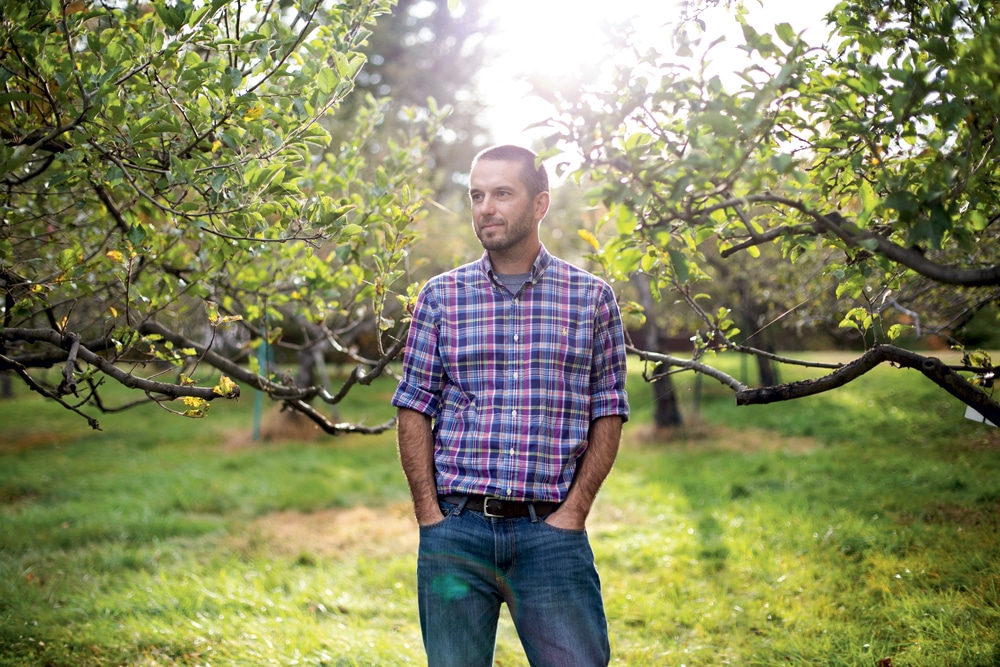Weekends with Yankee Q&A | Garden Guru Mark Richardson
New England botanic garden guru and Weekends with Yankee featured guest Mark Richardson talks fall blooms, how to get your garden in shape for spring, and apples vs. pumpkins.

A day at the office is a walk in the park for Mark Richardson, director of horticulture at Tower Hill Botanic Garden in Boylston, Massachusetts.
Photo Credit : Kayana SzymczakNot only does autumn at the New England Botanic Garden at Tower Hill offer sweeping foliage views of the Wachusett Reservoir, but it also means there are still plenty of plants in bloom across the 171-acre property in Boylston, Massachusetts. “It’s a great time to visit a botanic garden, and it’s a little quieter,” says Mark Richardson, director of horticulture at Tower Hill. “You can look at any level and see fall color.” (Another reason to go? The garden hosts its popular Autumn Illuminated evening walking tours in October.) Here, Richardson shares some insights on the fall season—and weighs in on the great pumpkin-versus-apple debate. —Courtney Hollands

Photo Credit : Kayana Szymczak
Q. Everyone’s always looking up to see fall color. What are some good reasons to look down?
There’s an obscure native plant called three-toothed cinquefoil, a tiny, shrubby ground cover that turns an amazing maroon, almost purple, in the fall and holds that color straight through winter. And one of my favorite ornamental grasses is little bluestem, which is light green during the growing season and then goes from rust to purple to silver in the fall; it’s showy for four to six weeks before it fades to light brown for the winter. Compared with spring, fall has a different pace—you have a lot more time to appreciate the color and the seasonal change.
Q. What are your favorite late bloomers in New England?
Native witch hazel, which can bloom until Thanksgiving, is subtle and beautiful, with straplike yellow petals. There’s another plant we have that’s extinct in the wild called franklinia, a small tree with absolutely stunning fall color. Someone once described its flowers as a fried egg: clear white outer petals and a bright yellow center. Stellaria also blooms pretty late, and of course there are asters and goldenrods. The typical New England meadowscape is just awash with color in the fall—lots of purples, pinks, yellows, and whites.
Q. What can home gardeners do now to get their gardens in good shape for spring?
Fall is perfect for planting trees and shrubs. As long as the soil stays above 45 degrees, you’re still getting a lot of active root growth. It’s also a great time to do lawn renovations—people like to aerate and seed their lawns in the fall and maybe spread some compost. You should also make sure your planting beds are covered in a decent layer of mulch before the winter, to protect the root systems.
Q. So, what should we do with all those raked leaves?
Use them to mulch your perennial beds—you can suck them through a shredder vacuum to break them down into smaller pieces, more like mulch material—or pack them into a cylinder made out of chicken wire, and within a year you’ll have a pretty rich compost. Leaves are like black gold. You definitely want to keep as many around as you can.
Q. What’s the best fall flavor: pumpkin or apple?
Definitely apple. Pumpkin is sort of a special dessert or treat, but I eat at least a few apples a day in the fall.
The New England Botanic Garden at Tower Hill is featured on season five of Weekends with Yankee. To find out how to watch, go to weekendswithyankee.com.


